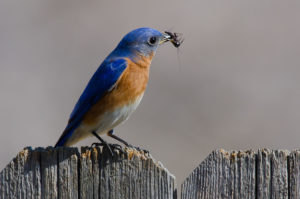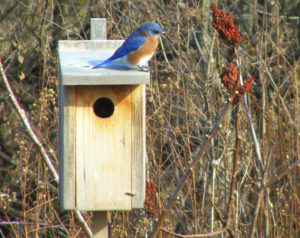Bluebirds are a symbol of happiness, springtime, and peace. They are also beneficial to our landscapes. Historically, both Native Americans and colonists used nest boxes and gourds to attract bluebirds to nest nearby and help control insect populations.
Problems for bluebirds arose however, from the 1920s through the 1970s. Populations declined due to loss of habitat, pesticide use, and competition from European bird species. So, in 1978 the North American Bluebird Society was formed. Conservation efforts began in earnest and a campaign to provide nesting sites was initiated. Today, bluebird populations are stable, and providing nest boxes through the year remains a great way to attract these harbingers of spring.
Site Requirements
To attract bluebirds to your property, first see if you have an appropriate site. Bluebirds like open meadows, and can often be seen on the edge of woods. Unfortunately, most suburban yards are to small to make them happy and lawns do not provide them with enough insects to eat. The good news is that there are many opportunities to attract bluebirds in unexpected places. For instance, open spaces such as naturalized stormwater basins may be excellent places to attract bluebirds. So even residents of townhouse communities and employees on corporate campuses have opportunities to attract these beautiful birds.
Nest Box Specifications
Given an appropriate site, bluebirds next need a place to nest. Since bluebirds are cavity nesters, they often use nests abandoned by other birds such as woodpeckers. Alternatively, they can use a house built by humans. Bluebird houses can be purchased, but are also easy to make.
Just remember, different bird species have different housing requirements, so if you are purchasing a nest box, make sure to get one specifically for bluebirds.
If you would like to build your own, the North American Bluebird Society provides instructions to build houses for our Eastern Bluebirds.
Whether purchased or built, nest boxes make excellent gifts!
Placement
Once you have your bluebird nest box, locate it properly. If possible, place it on a pole instead of a tree or fence post to deter predators such as raccoons. Face it toward an open area but away from prevailing winds. Also, placing it at eye level makes it convenient when checking it or cleaning it. Nest boxes should be cleaned after each brood fledges. Since bluebirds may have two or three broods in a season, you may need to clean it out several times.
And remember, if your site doesn’t suit bluebirds, it may be perfect for other bird species. Managing your site with an abundance of native plants, eliminating pesticides, and providing a source of water is sure to attract many types of feathered friends.
Also, check out our previous post “Winter Landscaping for the Birds” to learn what you can do to attract birds of all species.
Have you had success attracting bluebirds to your property? Have you built your own bluebird house? Share with us your success stories on Facebook or Instagram!



